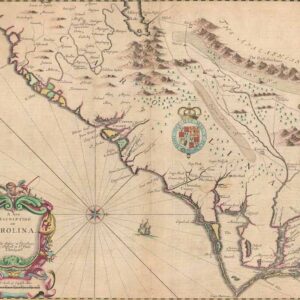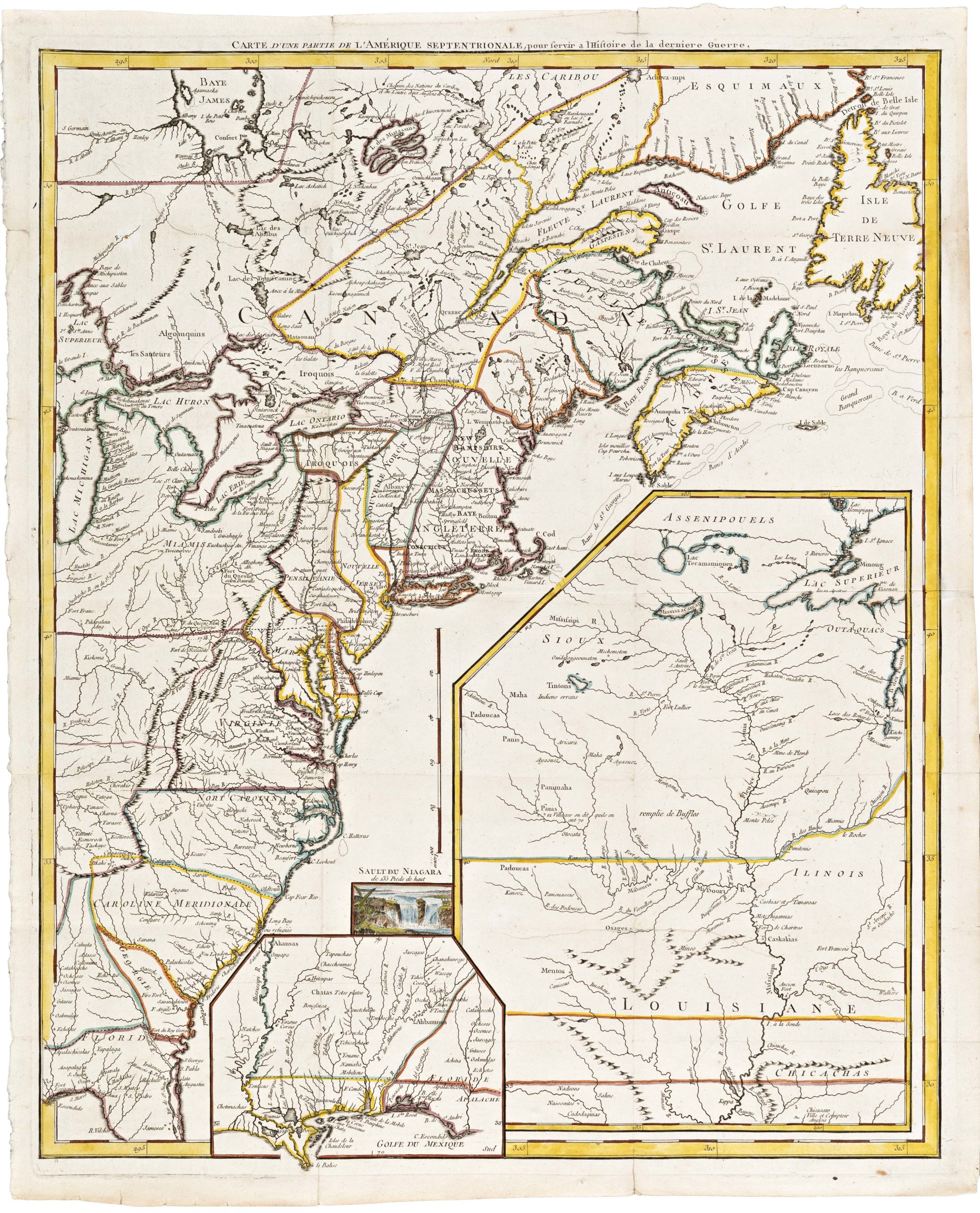Ruscelli/Rossacio’s 1599 map of the Eastern Seaboard: influential, important, highly aesthetic, and full of detailed and embedded stories.
Tierra Nueva.
Out of stock
Description
When Ruscelli first crafted this map of the North Atlantic seaboard, it was a pivotal moment in cartographic history. His work, intended for the first edition of his La Geografia di Claudio Tolomeo (1561), drew on earlier Italian charts but soon emerged as a significant influence. It was one of the first dedicated maps to spotlight the North American coastline, a feat that would shape our understanding of the region for centuries. This map, later included in Giuseppe Rosaccio’s 1598 edition of Ptolemy, underwent significant amendments and embellishments by Rosaccio, further cementing its historical significance.
The original 1561 map was based heavily on a 1548 map by Gastaldi, which focused strictly on delineating the coastline. Ruscelli added more detail about the interior, particularly a network of coastal rivers and one of the first depictions of a mountain chain in the North American interior. But a lot had happened since Ruscelli’s map was first created, and knowledge of the Americas constantly expanded and improved. Moreover, seminal mapmakers from Germany and Flanders had begun incorporating the latest discoveries and noting new toponyms on their maps. Rosaccio wanted to follow suit, leading him to update Ruscelli’s plate before including it in his edition. Among Rossacio’s sources was Ortelius’ map of America (1570), from which many of the changes seem to have been inspired. However, other Dutch mapmakers, such as Theodor De Bry, also influenced Rosaccio’s decision-making.
Rosaccio’s additions to Ruscelli’s original plate were decorative and preserved historical toponyms. The map now featured more mountains in the interior and entirely new islands in the North Atlantic, such as Icarus and Drogeo di Francis. Rosaccio also added many regional place names in the American interior, such as Avagal (from Ortelius 1570) or Virginia (from De Bry/White 1590), preserving these historical toponyms for future researchers.
Rosaccio even goes so far as to rename the continent India Nuova (upper left corner – immediately below is a printed note referring to Columbus’ discovery). Finally, Rosaccio adopted place names for topographic features, such as cape and coves, directly from Ortelius (e.g., C. de Laborador and C. Fredo). Despite the apparent adoptions, other new features have more obscure origins. The insertion of a river and lake in the far north, for example, or the very southern placement of the latest but well-known toponym, Terra Corte Real, is difficult to contextualize.
Neatline’s example of this excellent map is the updated state from the Rosaccio edition. We note that our map comes from the second edition of Rosaccio’s work, published in 1599, as a visible crack in the plate (bottom left corner) does not appear in the editions from 1598. It remains one of the earliest dedicated maps of the East Coast that one can freely acquire. The map covers the East Coast from Labrador in the north to the Carolina-Florida border in the south. It contains many place names, including sites that have since developed into well-known cities (e.g., New York/Angoulesme or Kitty Hawk/Larcadia in North Carolina).
We at Neatline think that Tierra Nueva is a fantastic map that is the ideal foundation to start a collection of this region and the history of North America.
Census
We have identified only three independent listings of this map with OCLC (no. 48663207), but many institutions carry the Rosaccio tome from which it derives. Examples appear on the market regularly, but they continue to command growing prices.
Cartographer(s):
Giacomo Gastaldi was one of the most prominent Italian cartographers, perhaps most recognized for his introduction of copperplate engraving in cartography or his frescoes of Africa and Asia in the Palace of the Doge. He was, in his time, named Cosmographer of Venice.
Girolamo RuscelliGirolamo Ruscelli (1518–1566) was an Italian mathematician, polygraph, and cartographer active in Italy during the early 16th century. He was born around 1518 in Viterbo to a family of minor nobility and humble origins. Throughout his life, Ruscelli moved around, living all over Italy. He started in Aquilea, but his work soon drew him to more important centers of learning. He moved first to Padua, and around 1540, he settled in Rome, where he founded his Accademia dello Sdegno. Around 1545, Ruscelli left Rome for Naples, and in 1548 he finally settled in the city that would make him most famous, Venice.
While posterity primarily remembers Ruscelli as one of the most important cartographers of the Venice School, his primary source of income came from publishing – both his works and copying the work of others. While he wrote on a broad range of subjects himself, the works plagiarised from others were often published by his partner, Plinio Pietrasanta. This lucrative relationship lasted until 1555 when Ruscelli was arrested and tried by the Inquisition for re-publishing a satirical poem by Pietrasanta without his formal permission. Any confrontation with the Inquisition was unpleasant enough, but Ruscelli may have been particularly susceptible to pressure because his wife’s family entertained Protestant sympathies. His brother-in-law was burned at the stake in Rome some years later.
The relationship with Pietrasanta had nevertheless soured, and the publishing firm was soon closed. Instead, Ruscelli partnered up with another Venetian publisher, Vincenzo Valgrisi. It was with Valgrisi that Ruscelli published his famous Ptolemaic Geografia in 1561. This atlas contained sixty-nine engraved maps sporting the latest ideas in Italian cartography. Despite containing some of the latest cutting-edge ideas about the world’s composition, Ruscelli’s atlas also drew heavily on earlier works. Forty of the 69 maps in Ruscelli’s atlas were copied almost directly from Giacomo Gastaldi’s Geografia from 1548.
Despite Ruscelli’s fame as a cartographer, he also achieved considerable recognition under his pseudonym Alessio Piemontese. His greatest success in this regard came the same year as his arrest (1555), with the publication of De Secreti del Alessio Piemontese. In this book of alchemy, Ruscelli reveals himself as a true Renaissance man, dabbling proficiently in multiple disciplines at the same time. His ‘Secrets‘ contained instructions on how to make everything from alchemical compounds and medicines to cosmetics and dyes. The work was so popular that it was re-issued numerous times over the next two centuries, and translated into French, English, German, Latin, Dutch, Spanish, Polish, and even Danish.
Giuseppe RosaccioLittle is known about the life of Giuseppe Rosaccio (c. 1530 – 1620), a Venetian geographer and scholar.
Condition Description
Very good. Adhesive residue along top edge. Some bleed through from the verso. Centerfold reinforcement on verso.
References




